Every parent knows the struggle with how to measure baby shoe size. Baby’s feet seem to grow overnight. Too tight shoes, and your little one’s toes are squished; too loose, and they’re tripping over every step.
The good news? You don’t need to visit a shoe store or invest in special tools to get the perfect fit. With just a sheet of paper, a pencil, and a few minutes, you can accurately measure your baby’s feet right at home.
In this guide, we’ll walk you through a simple step-by-step method on how to measure baby shoe size. We’ll explain why correct shoe sizing matters, share age-based size charts, and highlight common mistakes.
Why Correct Shoe Sizing Matters for Babies
It might surprise you how much your baby’s tiny feet can change in just a few months. During the first year, those adorable little toes are growing faster than any other part of their body — sometimes a full shoe size every two to three months!
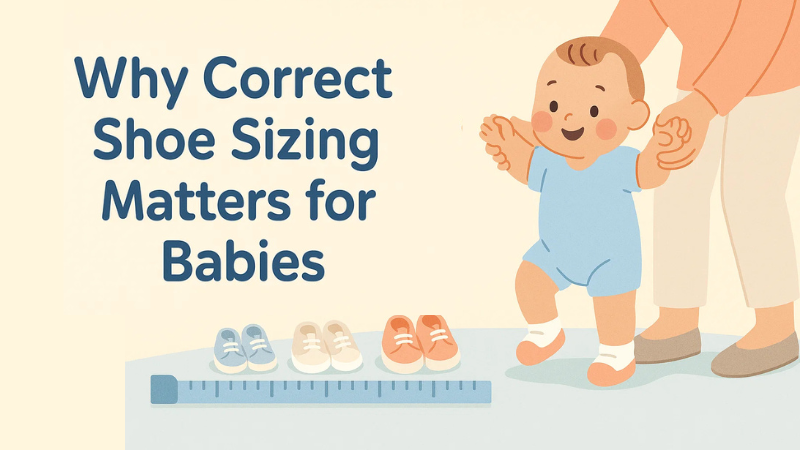
Getting the right shoe size is essential for your baby’s healthy foot development, balance, and posture. Shoes that fit properly help your little one move naturally, build confidence with each step, and prevent common issues that can affect walking in the long term.
Babies’ feet are made mostly of soft cartilage and fat pads in the early months. As they grow and start standing or walking, these bones begin to form and strengthen. That’s why the right fit makes such a difference:
- Tight shoes can restrict movement, cause blisters, and even affect bone growth.
- Shoes that are too loose can lead to instability, tripping, and poor balance.
The ideal baby shoe should feel snug but never tight, with just enough room at the toes to wiggle freely. This allows natural muscle development and helps your baby learn to walk more confidently.
Expert Tip:
A properly fitted pair of shoes will support your baby’s arch and heel while giving flexibility to bend and move. Think of it like the foundation of a house — strong, stable, and designed to grow with your child.
Bottom Line:
Choosing the right size today lays the foundation for your baby’s healthy steps tomorrow. Regularly measuring those fast-growing feet ensures each new pair of shoes supports comfort, safety, and happy adventures ahead.
How to Measure Baby Feet at Home
Getting the right shoe size for your baby doesn’t have to be complicated — and you definitely don’t need a trip to the store every time those little feet grow! In fact, with just a few simple tools you already have at home, you can get accurate results in minutes.
This easy, no-fuss method helps you measure your baby’s foot length precisely so you can choose the right shoe size every time. Whether you’re buying shoes online or checking your baby’s growth, this step-by-step process ensures a comfortable, confident fit.
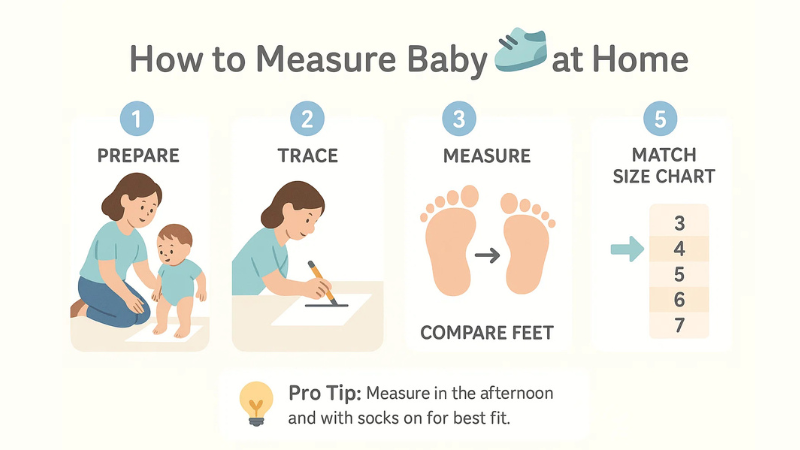
Step-by-Step: How to Measure Baby Shoe Size at Home
What You’ll Need:
- A clean sheet of paper
- A pencil or marker
- A ruler or measuring tape
- A calm baby (or at least a cooperative one for a few seconds!)
Step 1: Prepare a Flat Surface
Place a sheet of plain paper on a hard, flat floor — not on carpet or a soft surface. Make sure your baby is standing, if possible, with weight evenly distributed on both feet. If your baby can’t stand yet, gently press the foot flat against the paper while seated.
Step 2: Trace the Foot
Hold your baby’s foot steady and mark the heel and the tip of the longest toe with a pencil. Be sure to keep the pencil upright for accuracy — angling it can add extra millimeters to your measurement.
Step 3: Measure the Length
Using a ruler or tape measure, measure the distance between your two marks (heel to toe). Note the measurement in centimeters or inches — whichever is easier for you.
Step 4: Measure Both Feet
It’s normal for one foot to be slightly larger than the other, even in babies. Always use the larger foot’s measurement as your guide when choosing shoe size.
Step 5: Match with a Reliable Size Chart
Use your baby’s foot length and compare it to a trusted baby shoe size chart (like the one below). Keep in mind that sizes may differ slightly between brands, so always double-check before purchasing.
Pro Tip:
Measure your baby’s feet in the afternoon or evening. Like adults, babies’ feet can swell slightly throughout the day, so measuring later ensures a more accurate fit for daily wear.
Bonus Tip:
If your baby will wear socks with their shoes, measure while they’re wearing socks — this gives a more realistic fit.
Bottom Line:
Measuring your baby’s shoe size at home takes less than five minutes but makes a world of difference in comfort and foot health. Regular measurements (every 2–3 months) help you stay one step ahead of growth spurts — so your little explorer always has shoes that fit just right.
Baby Shoe Size Guide by Age
Even after measuring your baby’s feet, it can still be tricky to know exactly which shoe size to buy — especially since sizes vary by brand and region. That’s where a baby shoe size guide by age comes in handy.
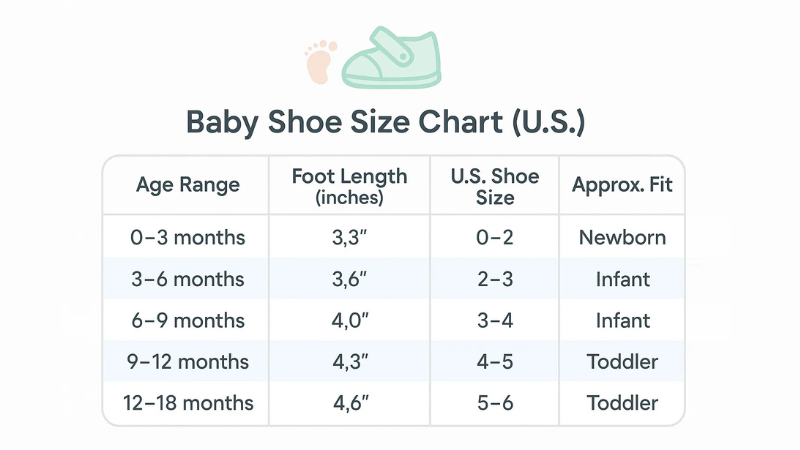
This easy-to-follow chart gives you a quick reference point for choosing the right shoe size based on your baby’s age and foot length. It’s not a one-size-fits-all solution (every little one grows differently!), but it’s a great place to start.
| Age Range | Foot Length (inches) | U.S. Shoe Size | Approx. Fit |
| 0–3 months | 3.3″ | 0–2 | Newborn |
| 3–6 months | 3.6″ | 2–3 | Infant |
| 6–9 months | 4.0″ | 3–4 | Infant |
| 9–12 months | 4.3″ | 4–5 | Toddler |
| 12–18 months | 4.6″ | 5–6 | Toddler |
How to Use This Chart
- Find your baby’s measured foot length in inches or centimeters.
- Match it with the closest range in the chart above.
- Select the corresponding U.S. shoe size when shopping.
If your baby’s foot falls between two sizes, always go one size up to allow room for growth and comfort.
Important Note:
This guide provides a general size reference, but shoe sizing can differ slightly depending on the manufacturer or country. Always check the specific brand’s sizing chart when possible, especially for online purchases.
Pro Tip:
For the most accurate results, measure your baby’s feet every two to three months. Babies’ feet can grow as much as half an inch in that time — and a good fit today might be snug tomorrow!
Bottom Line:
This baby shoe size guide by age gives you a reliable starting point, but the best fit always comes from actual measurements. Pair this chart with our at-home measuring method, and you’ll never have to guess your baby’s shoe size again.
Common Mistakes When Buying Baby Shoes
We’ve all been there — you find the cutest little pair of shoes and can’t resist grabbing them, thinking “they’ll grow into it.” But when it comes to baby shoes, guessing the size or focusing only on looks can actually do more harm than good.
To help you avoid wasted money (and uncomfortable tiny toes), here are the most common mistakes parents make when buying baby shoes — and how to easily fix them.
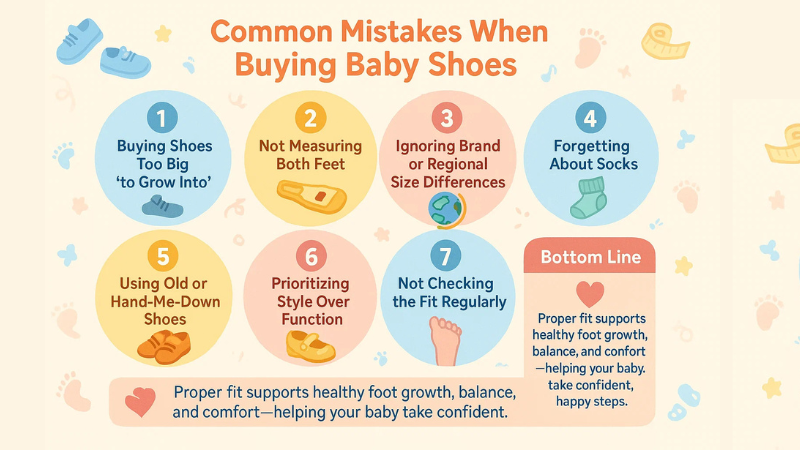
Buying Shoes That Are Too Big “to Grow Into”
It’s tempting to size up, especially when babies grow so quickly. But oversized shoes can cause tripping, slipping, and difficulty balancing — especially for first-time walkers.
Tip: Always allow just one thumb’s width of extra space at the toes — that’s enough room to grow without affecting stability.
Not Measuring Both Feet
Most babies have one foot slightly larger than the other (and it’s completely normal!). Ignoring this can result in one shoe fitting perfectly and the other feeling tight.
Tip: Always measure both feet and use the larger measurement when choosing a shoe size.
Ignoring Brand and Regional Differences
A U.S. size 4 isn’t always the same as a U.K. or EU size 4 — and even brands within the same region can differ slightly.
Tip: Always check the brand’s official size chart before purchasing, especially for online orders.
Forgetting About Socks
Trying on shoes without socks might seem easier, but it gives a false sense of fit. Socks take up a bit of space, which can make shoes feel tighter once worn regularly.
Tip: Have your baby wear the socks they’ll use most often when testing new shoes
Using Old or Hand-Me-Down Shoes
While hand-me-downs save money, worn-out shoes often lose their original shape and cushioning. This can cause pressure in the wrong places and hinder proper foot support.
Tip: If using hand-me-downs, ensure they still have a firm heel, intact soles, and even wear.
Prioritizing Style Over Function
Tiny sneakers and glittery boots are adorable — but fashion shouldn’t come before function. The right baby shoes should support balance, flexibility, and breathability first.
Tip: Look for lightweight, soft-soled shoes made from natural, breathable materials like cotton, leather, or mesh.
Not Checking the Fit Regularly
Babies’ feet grow incredibly fast, and a shoe that fit last month might already be too small.
Tip: Check the fit every 6–8 weeks. If you notice redness, imprints, or your baby pulling at their shoes, it’s time to size up.
Bottom Line:
A perfect baby shoe does more than look cute — it helps your little one develop strong, healthy feet and steady steps. By avoiding these common mistakes and focusing on fit, comfort, and flexibility, you’ll make every step your baby takes safer and happier.
Tips for Getting the Right Fit for Infants
Getting baby shoes that fit properly isn’t just about comfort — it’s about helping tiny feet develop strength, stability, and confidence. Here’s a detailed guide for parents to ensure every step your little one takes is safe and comfortable.
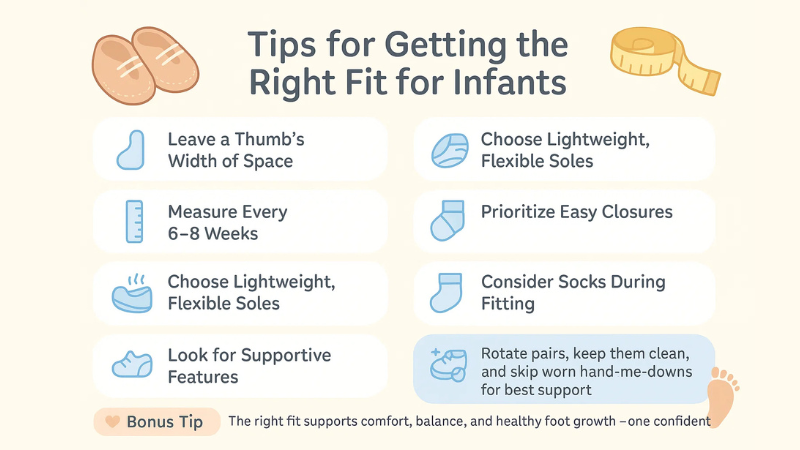
Leave a Thumb’s Width of Space at the Toes
It’s tempting to pick a shoe that fits snugly — but babies’ feet need room to wiggle and grow.
- Why it matters: Tootight shoes can restrict natural movement, cause blisters, and slow foot development.
- Pro Tip: After measuring, ensure the shoe allows one thumb-width (roughly half an inch) of extra space at the tip of the longest toe. This little wiggle room makes a big difference in comfort and growth.
Measure and Recheck Every 6–8 Weeks
Babies’ feet grow incredibly fast — sometimes a full shoe size every 2–3 months.
- Why it matters: Shoes that fit last month may already be too small, causing discomfort or even toe deformities over time.
- Pro Tip: Schedule a quick foot check every 6–8 weeks. Compare measurements with your baby’s current shoes and size chart to ensure a perfect fit.
Choose Lightweight, Flexible Soles
Rigid shoes may look sturdy, but they restrict foot motion — critical for early walkers.
- Why it matters: Soft, flexible soles allow babies to feel the ground and strengthen foot muscles, balance, and coordination.
- Pro Tip: Look for shoes made with soft leather, rubber, or mesh soles that bend easily at the ball of the foot.
Pick Breathable, Comfortable Materials
Babies’ feet are sensitive and prone to sweating. Shoes made from synthetic, non-breathable materials can lead to irritation or rashes.
- Pro Tip: Opt for natural fabrics like cotton, soft leather, or mesh. They keep feet cool, dry, and happy.
Prioritize Easy-to-Use Closures
Tiny shoes should be easy for parents to put on and take off while staying secure on the foot.
- Why it matters: Frustrating closures can lead to uneven wear or improper fit.
- Pro Tip: Velcro straps, elastic laces, or slip-on designs are perfect for quick changes, especially for busy mornings or diaper changes.
Consider Socks During Fitting
Babies usually wear socks, so testing shoes without them can give inaccurate sizing.
- Pro Tip: Always have your baby wear their usual socks when trying on new shoes. This ensures an accurate fit and prevents shoes from being too tight
Look for Extra Features for Support
Some baby shoes offer reinforced heels or soft padding, which can improve stability for first steps. While not mandatory, these features can help toddlers feel more secure as they learn to walk.
Bonus Tip: Extend Shoe Life
If you want your baby shoes to last a little longer:
- Rotate pairs to prevent rapid wear.
- Keep them clean and dry.
- Avoid hand-me-downs that have lost shape, as they won’t provide proper support.
Bottom Line:
The right fit isn’t just about the number on the label — it’s about comfort, support, and flexibility. By following these practical tips, you’ll ensure your baby’s shoes help their feet grow healthy, strong, and happy, while making every first step a safe and joyful milestone.
Conclusion
Measuring your baby’s shoe size correctly is a small step that makes a big difference in their comfort and development. With the right tools, proper measurement, and regular checks, you’ll ensure healthy foot growth and happy first steps.
Before buying, remember to double-check fit and material quality — your baby’s feet will thank you!
Explore more guides to keep your family’s footwear in top shape:
- Best Shoes for New Nurses (Comfort Guide)
- How to Clean Nursing Shoes Without Damage
- How to Store Shoes Properly
FAQs
How often should I measure my baby’s feet?
Every 2–3 months, or sooner if shoes seem tight.
Should baby shoes fit tightly or loosely?
Shoes should fit snugly but still allow a little wiggle room for the toes.
Are socks necessary for newborn shoes?
Yes, soft socks help with comfort and prevent rubbing.
What’s the best type of shoe for first walkers?
Flexible, soft-soled shoes made from breathable materials.
Can I measure my baby’s feet without a chart?
Yes, tracing on paper works fine — just use a ruler for accuracy.

Leave a Reply